Ecology, Ornithology and Nature
Understanding the potential for a development to impact on habitats, birds and other species is an important part of the Environmental Impact Assessment process.
We have…
- Undertaken a series of desk-based studies and consultations with organisations including Scottish Natural Heritage (SNH), RSPB and Local Fisheries Boards to identify known species and habitats.
- Undertaken baseline ecological surveys on site for protected species and habitats.
- Undertaken breeding bird and flight activity surveys in 2019 and 2020.
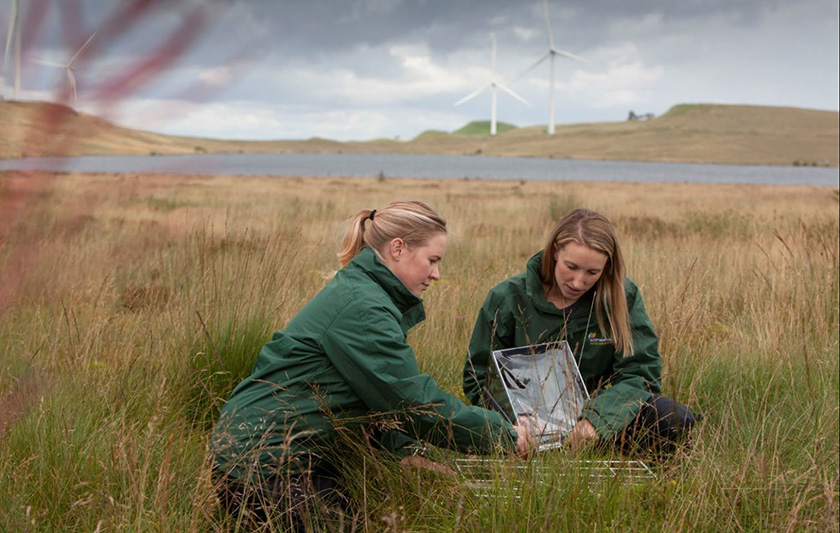
Above: SPR’s inhouse ecology team conducting conservation fieldwork
We found…
Euchanhead is not a statutorily designated nature conservation site, and consists primarily of commercial forestry. This provides a suitable habitat for a number of species under varying levels of protection.
The surveys found evidence of protected species including; otter, water vole, red squirrel and pine marten. Bird surveys to date have shown only low levels of bird activity with regard to birds of high and moderate nature conservation Importance.
Some sensitive habitats were also identified. The surveys undertaken on the site haven’t revealed any species that have required changes to the site design.
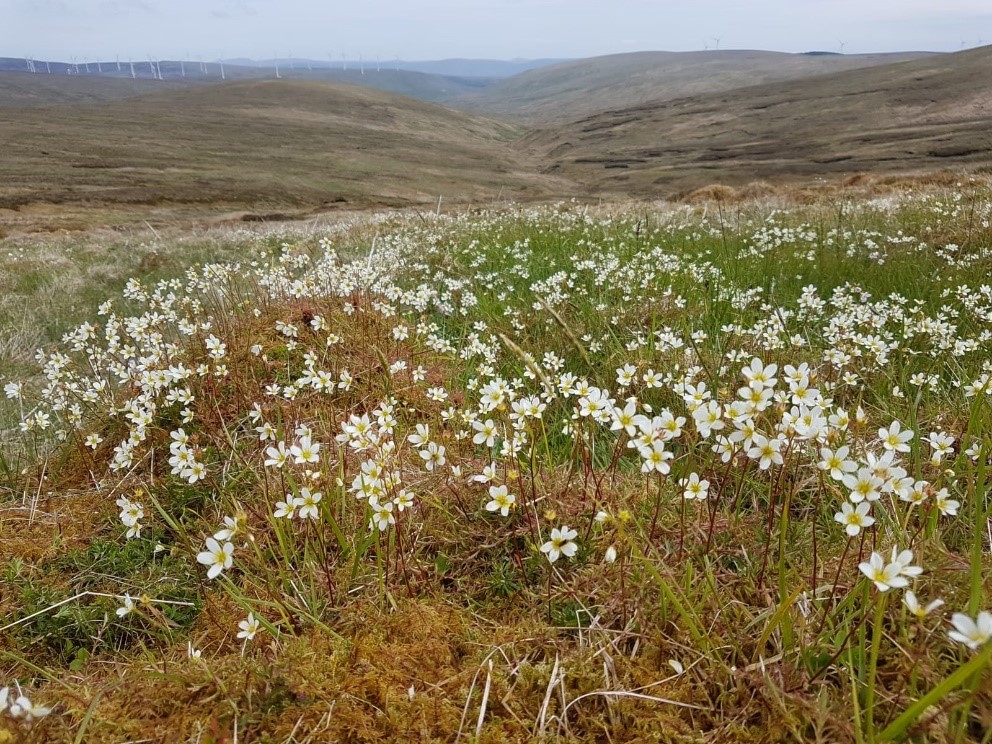
Above: Mossy Saxifrage wild flowers at Euchanhead RED site
SPR will seek to mitigate impacts on ecology in a variety of ways:
- Avoiding construction during the bird breeding season where possible, or where not possible undertaking surveys to identify and protect any nesting birds.
- Avoiding areas of blanket bog identified during the Phase 1/NVC vegetation surveys.
- Pollution control measures to prevent silt or dusts entering watercourses.
- Designing any new or upgraded watercourse crossings to maintain safe passage of fish.
Any potential adverse effects for any species will be mitigated to meet the applicable standards and species-specific mitigation plans will be created for each as required.
Our understanding of the ground conditions and surface water network has informed the site design. This minimises the risk of groundwater and surface water being adversely affected. Our technical specialists work closely with one another to ensure that the potential effects of the development on hydrology and related habitats and species are considered holistically. This is particularly important for Ground Water Dependent Terrestrial Ecosystems, for example.
We have…
Avoided watercourses on the site, as far as possible, we have also investigated peat depths across the site, identified the location of private water supplies and the potential for flooding from the watercourses.
We found…
Our technical teams have identified the key hydrological components in and around the proposed Development. This allows us to understand how rainfall and surface water run off infiltrates into soils and peat and discharges into watercourses and drainage channels.
This information has also allowed us to assess whether any private water supplies are potentially at risk of being affected by construction works.
The peat surveys revealed that only localised deposits of peat are found across the site, with only the area around turbine 12 having a larger area of peat
During the construction phase, pollution of water entering watercourses will be prevented through a range of measures including the use of silt traps, settlement ponds and cut off drains, as well as a surface water monitoring programme. This is to ensure that water quality in all downstream watercourses, including the River Nith, Ken and the Shinnel Water, is protected and maintained.
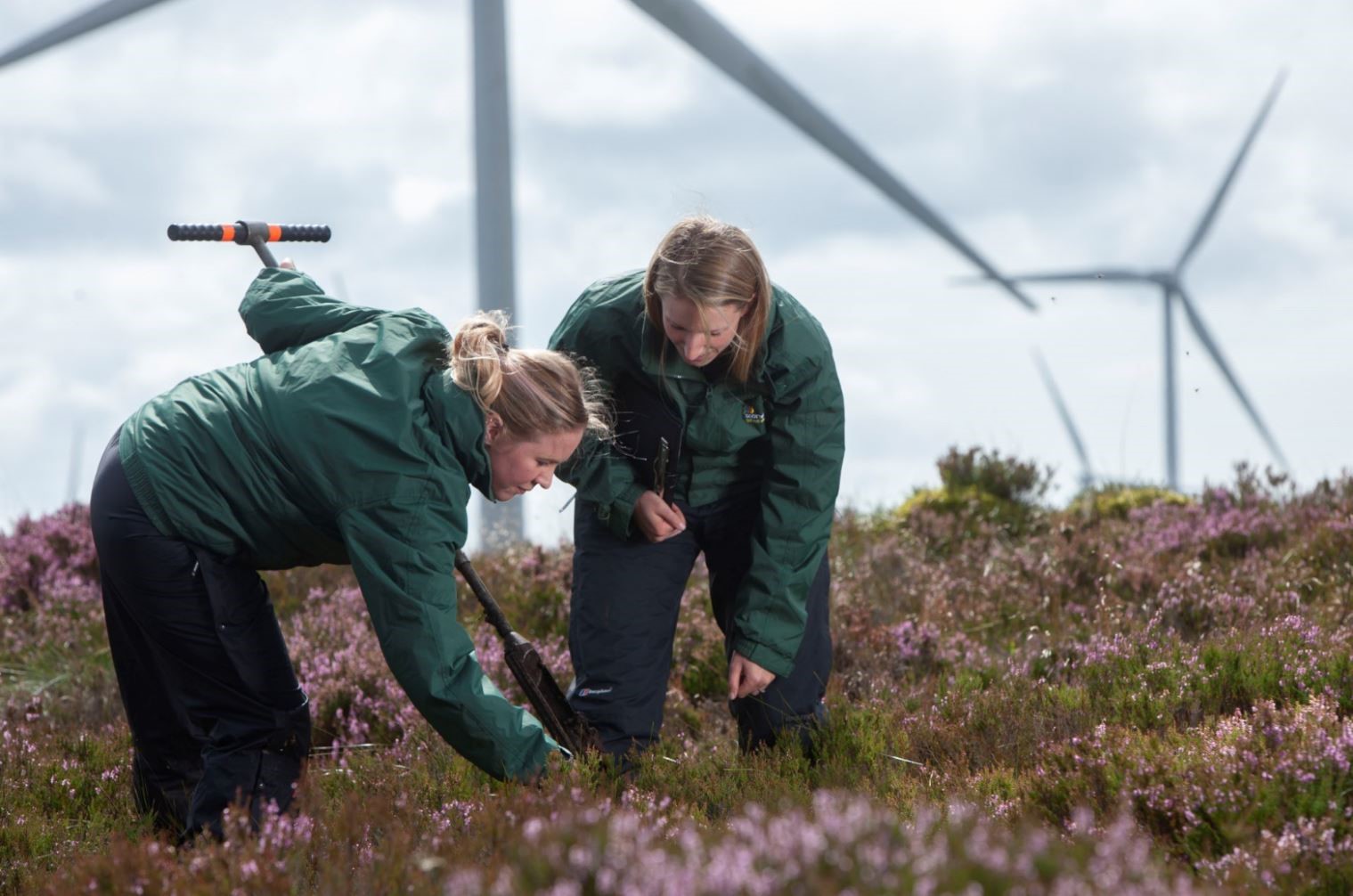
Above: SPR’s inhouse Ecology Team conducting onsite fieldwork
Archaeology relates primarily to the buried remains and artefacts that could be affected by the construction works related to the building of the proposed Development.
Cultural heritage generally relates to other sites, features and locations in the wider landscape which have the potential to have their setting affected by the proposed Development.
We have…
Undertaken a desk based study to identify all known assets registered with national and local archaeological bodies, as well as a site walkover to identify any previously unknown assets.
We found…
No designated heritage assets (World Heritage Sites, Inventoried Battlefields, or Inventoried Garden and Designed Landscapes) are found within the proposed Development boundary.
Allen’s Cairn, a covenanters memorial, sits within the proposed Development site boundary, close to Wether Hill.
Three previously unreported sites were discovered during the walkover survey. These are; a sheiling, a farmstead and a potential archaeological feature.
Protecting assets during construction.
An archaeological watching brief is proposed during construction to identify, record and, where appropriate, protect any remains that are uncovered.
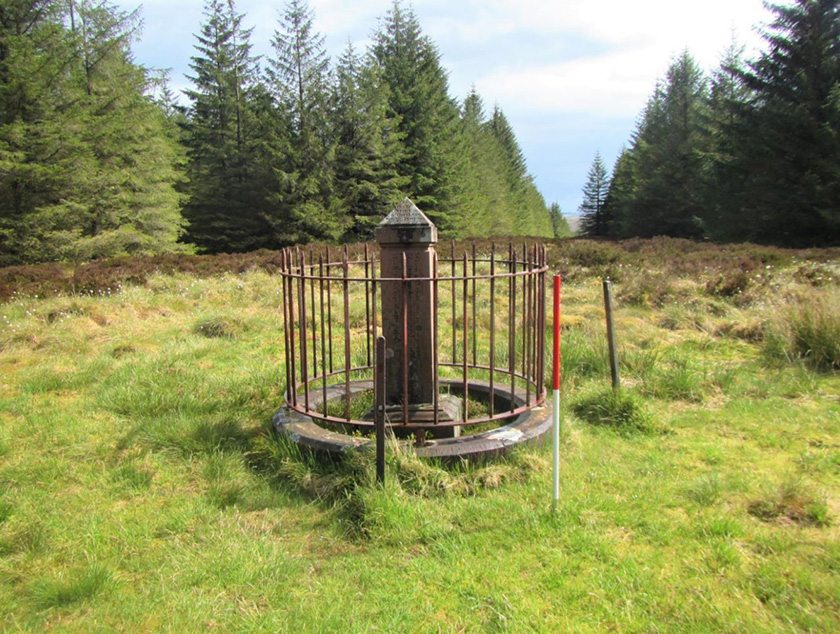
Above: Allan’s Cairn – Covenanter memorial in Polskeoch Forest
We have…
SPR is undertaking a detailed study of the noise environment. This has included using existing background noise data from nearby windfarms and noise modelling to predict likely levels of wind turbine noise. Existing and predicted noise levels will be considered against the current guidance to determine if impacts will be significant.
We found…
Since the first public information day, and following detailed wind analysis, discussions with local residents and preliminary noise assessment work, it was established that there was scope to add an additional turbine to the site layout.
In addition, the potential impact of noise from the proposed Development has been continuously assessed during the design process, and the layout refined through the appropriate siting of turbines in relation to identified residential properties. In particular turbines have been sited further away from the Shinnelhead property.
Protecting residents during construction.
Noise from construction activities will be controlled through the use of a Construction Environmental Management Plan.
We have…
SPR and our technical consultants have assessed the potential impacts on access, traffic and transport. This considers the potential effects of the proposed Development on the transport network, primarily in relation to construction vehicles.
These studies also considered the route to the Site from the nearby ports, and the potential for environmental effects of vehicles using the public road network.
We found…
Abnormal load access is anticipated to be from the A76, bringing the turbine components from either the King George V Dock in Glasgow, or from Port of Ayr. Both routes are proven for wind turbine component delivery.
Two access routes to the Site (A & B) have been identified as being suitable for the delivery of wind turbine blades and other components, as well as general construction traffic.
Both routes are considered suitable for the delivery of turbine components and construction traffic. Only one route would be used for the delivery of the turbine component.
Access Route A
Uses the existing SPR Hare Hill Windfarm access junction from the A76 and existing site roads, before approximately 8.2 km of new access track would be constructed running from the existing Hare Hill Windfarm south past Laglass Hill and Blackcraig Hill, before turning east at Greenlorg Hill and entering the Site near Graystone Hill. Some track alterations to the existing tracks would be required to allow larger components to access the Site.
Access Route B
This route accesses the Site via a combination of Blackaddie Road, which runs from the A76 along the north western edge of Sanquhar, and the bypass road purpose purpose-built for the construction of Whiteside Hill Windfarm. It enters the Site close to Glenglass cottage.
Delivery of the larger turbine components to Site during construction will require careful management and scheduling and all heavy good vehicles and abnormal load traffic will use the agreed access route. Once operational, impacts on traffic and transport from the proposed Development will be minimal.
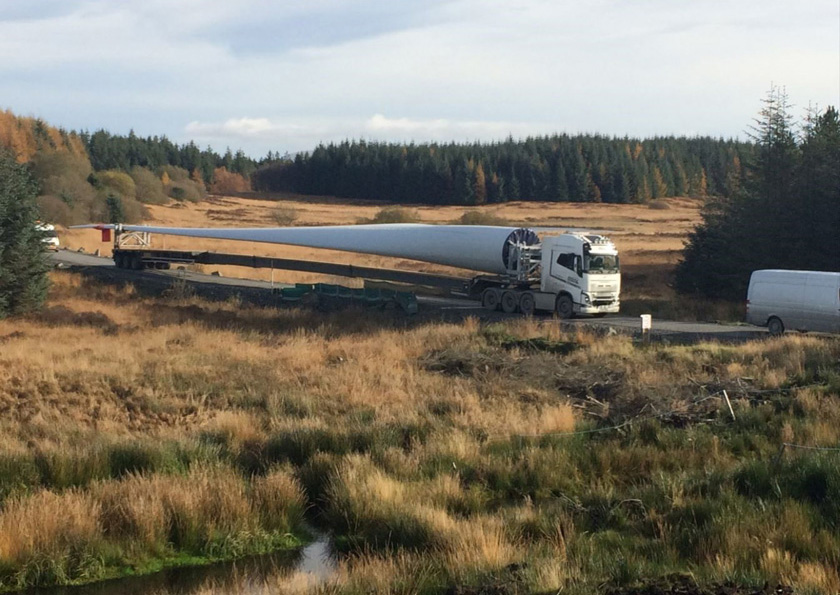
Above: Blade Image shows delivery vehicle with 57 m blade, Euchanhead blades will be up to 75 m in length
Protecting road users and residents
In order to minimise the impact on local residents and other road users, a Construction Environmental Management Plan and a Traffic Management Plan will be produced. The following practices will be used:
- Construction vehicles to use approved access routes and adhere to any necessary restrictions.
- Erection of appropriate temporary signage in the vicinity of the site warning of construction traffic
, and warning other users of abnormal load turbine movements. - Abnormal loads will be escorted from the port of entry with timings agreed with the road authorities and police as appropriate.
- Ground preparation, including protection of services.
- Arrangements for road maintenance, wheel washing and road sweeping where necessary.
An assessment of the potential socio-economic, tourism and recreation impacts of the proposed Development is being undertaken as part of the Environmental Impact Assessment Report.
We have…
Reviewed the existing baseline conditions, including the identification of local recreational groups, tourist attractions and business/employment conditions and an assessment of the potential effects of the proposed Development against these baseline conditions.
We found…
The construction and operation of the proposed Development has the potential to benefit the local and regional economies through:
- Direct construction and operation employment opportunities.
- Indirect employment further down the supply chain for those companies providing services to the contractors during the construction and operation phases of the development.
What we will do…
- We will seek to use local labour where possible to maximise the benefits to the local economy.
- Whilst there will be restrictions on access to the site during construction for health and safety reasons, we are committed to making provision for access during the operation of the proposed Development.
- We will continue to consult with recreational groups to identify and respond to any opportunities and areas of concern.
- We will engage with local schools and educational establishments to share knowledge and build relationships.
- We will work with the community to develop the Community Benefit and investment opportunities in a way that responds to their needs.
Wind turbines have the potential to interfere with military and civil aviation operations, primarily through effects on radar, but also if they are sited within military low flying areas.
We have…
The project team has consulted with relevant stakeholders (MOD, CAA and NATS) and has also undertaken an assessment in relation to aviation activity in the area.
We found…
The radar propagation model suggests that the turbines will be visible by Glasgow Prestwick and NATS radar systems.
Discussions with NATS and Glasgow Prestwick are under way to establish a technical solution that is acceptable to all parties.
We have…
Undertaken consultation with relevant bodies to establish the presence of utilities and telecommunication links across the site.
We found…
No telecommunication links have been identified that will be affected by the development.
SP Energy Networks (SPEN) operate a power line which runs across the northern body of the site.
The current land use of the site is a commercial forest.
A Development Forest Design Plan will be produced as part of the EIA process to show which woodlands would be felled to facilitate the proposed Development and how the forest will be re-stocked during the life of the proposed Development.
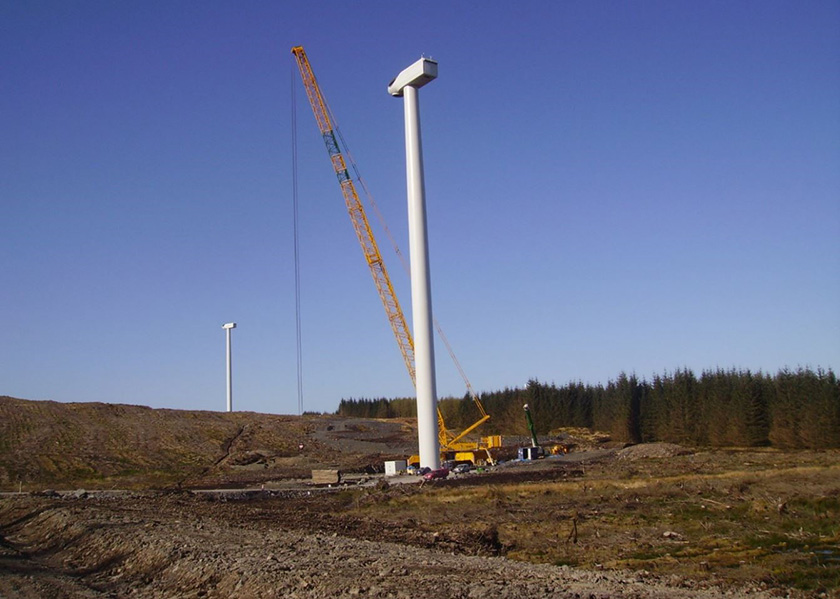
SPR’s Kilgallioch Windfarm during construction
Embedded Design
A number of design mitigations have been embedded into the site design as a result of the EIA surveys. These include:
- Turbines are located such that that they are at least 1800 m from the nearest noise sensitive receptor.
- We have sought to avoid areas of deep peat as far as practicable.
- Some more sensitive vegetation habitats have been identified resulting in the relocation of some turbines.
- Impacts on watercourses have been minimised by retaining a buffer of 50 m from any of the turbines, cranepad hardstandings, temporary compounds or the substation in the site design.
- The road layout uses as much existing forestry road as possible, reducing the amount of new track and water crossings required for the construction of the proposed Development.
- The site design avoids any known designated assets through applying a buffer.
- Appropriate stand off distances have been integrated into the site design to ensure there is no impact on the SPEN power line.
In addition, SPR will ensure there are no detrimental effects for residents on their telecommunication services.
Go back to the main pageGo to the next page